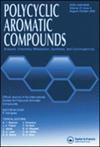用于高效有机太阳能电池的茚并二呋喃基非富勒烯受体的分子工程设计
IF 2.6
3区 化学
Q2 CHEMISTRY, ORGANIC
引用次数: 0
摘要
高能效非富勒烯受体在开发高效有机太阳能电池(OSC)方面备受关注。尽管已开发出许多材料来改善有机太阳能电池的光学和光电性能,但这些材料仍有许多不足之处。本文章由计算机程序翻译,如有差异,请以英文原文为准。
Molecular Engineering of Indacenodifuran-Based Non-Fullerene Acceptors for Efficient Organic Solar Cells
Energy-efficient non-fullerene acceptors attracting great attention for developing efficient organic solar cells (OSCs). Though many materials have been developed to improve the optical and optoelectronic characteristics of OSCs, the search continues to strengthen this field further. Therefore, herein, we designed an environmentally-benign indacenodifuran-based electron acceptor molecules (MH1-MH8) by substituting various end-capped electron-withdrawing moieties (COOH, SO3H, NO2, and CN). The open-circuit-voltages, binding energy, transition energy, transition density analysis, and electron and hole reorganization energies for MH1–MH8 were computed for these materials. These designed materials MH1-MH8 have better photovoltaic, photophysical, and electrical properties than R due to their narrower bandgap (1.91 eV), higher absorption (725.56 and 785.46 nm in gas and chloroform), low-mobility of electrons (0.0033) and holes (0.0019), and lower binding energy of 0.20 eV). We have also performed a charge transfer study by establishing a donor:acceptor complex MH2:PTB7-TH, showing a great charge transformation at the donor:acceptor interface. Thus, the designed compounds (MH1-MH8) with excellent optoelectronic properties could be considered a promising and environmentally friendly option to create compelling organic solar cells.
求助全文
通过发布文献求助,成功后即可免费获取论文全文。
去求助
来源期刊

Polycyclic Aromatic Compounds
化学-有机化学
CiteScore
3.70
自引率
20.80%
发文量
412
审稿时长
3 months
期刊介绍:
The purpose of Polycyclic Aromatic Compounds is to provide an international and interdisciplinary forum for all aspects of research related to polycyclic aromatic compounds (PAC). Topics range from fundamental research in chemistry (including synthetic and theoretical chemistry) and physics (including astrophysics), as well as thermodynamics, spectroscopy, analytical methods, and biology to applied studies in environmental science, biochemistry, toxicology, and industry. Polycyclic Aromatic Compounds has an outstanding Editorial Board and offers a rapid and efficient peer review process, as well as a flexible open access policy.
 求助内容:
求助内容: 应助结果提醒方式:
应助结果提醒方式:


